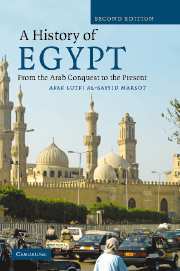Book contents
- Frontmatter
- Contents
- List of maps
- Preface
- Map 1 Egypt and its neighbours
- Map 2 Medieval Cairo
- 1 The Arab conquest of Egypt to the end of the Ayyubi dynasty, 639–1250
- 2 The age of the mamluks, 1250–1516
- 3 The Ottoman age, 1516–1805
- 4 The beginning of the state system, 1805–1922
- 5 The liberal experiment, 1922–52
- 6 The Nasser years, 1952–70
- 7 From Sadat to Mubarak, 1970 to the present day
- Select bibliography
- Index
4 - The beginning of the state system, 1805–1922
Published online by Cambridge University Press: 05 June 2012
- Frontmatter
- Contents
- List of maps
- Preface
- Map 1 Egypt and its neighbours
- Map 2 Medieval Cairo
- 1 The Arab conquest of Egypt to the end of the Ayyubi dynasty, 639–1250
- 2 The age of the mamluks, 1250–1516
- 3 The Ottoman age, 1516–1805
- 4 The beginning of the state system, 1805–1922
- 5 The liberal experiment, 1922–52
- 6 The Nasser years, 1952–70
- 7 From Sadat to Mubarak, 1970 to the present day
- Select bibliography
- Index
Summary
Muhammad Ali's reign in Egypt can be divided roughly into two periods. For the first few years he spent his time consolidating his rule and eliminating opposition. The second phase was spent in economic and military expansion. He and his supporters – his Turco-Albanian cohorts, local Muslim and minority tujjar – all contrived to establish a centralized authority that brought law and order, thereby reviving trade and commerce.
The new governor spent his early years either cajoling and bribing mamluk beys to join his ranks or fighting those who resisted until he became sole master in the land. This was achieved by 1811, when the last of the mamluks were invited to a ceremony at the citadel, ambushed and killed. The incident was a minor mopping-up operation and exterminated some twenty-four beys along with their lieutenants. This was an age of bloody incidents and the new wali did no more to the mamluks than they would have done to him had their positions been reversed.
By that time plans for the future of Egypt had become clearer to the new governor, and a regular programme of action was being sketched out in his mind. To begin with, Muhammad Ali and his supporters were mercantilists who believed in expanding agriculture for export, as some tujjar had done under the mamluks, but they also wished to introduce industrialization so as to benefit from the agricultural raw materials grown locally and become self-sufficient, thus preventing bullion from being exported.
- Type
- Chapter
- Information
- A History of EgyptFrom the Arab Conquest to the Present, pp. 65 - 97Publisher: Cambridge University PressPrint publication year: 2007
- 1
- Cited by



